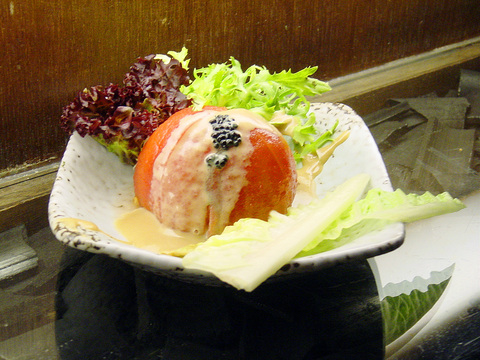If you seek culinary refinement in a relaxing, homely dining environment, look no further. The sake bar Tanukikoji on Anhe Road has garnered a crowd of frequent customers with its top-rated delicacies and a wide range of sake sourced from across Japan.
A small joint seating around 20 people with a function room on the side, Tanukikoji presents an open dining space accommodating an elegant long wooden bench inlaid with glass. The menu is best described as Japanese fusion and features sets of sushi, sashimi, grilled meats and seafood with a creative twist.
The most popular on the sushi list is the sea urchin. According to one of the proprietors, Andy Luo (羅安得), the chef uses top-quality sea urchins imported from Hokkaido — they are small but sweet, which means they need little seasoning.

PHOTO: HO YI, TAIPEI TIMES
Another highlight on the menu is raw beef slices. The secret to the dish's divine taste is the sesame sauce, sweet onion and, of course, the fresh, tender beef.
“We are a bunch of gourmets who only go for the best ingredients and foods. Once you have the A-grade ingredients at hand, all you need to do is to bring out the original taste,” Luo said.
The strategy seems to work well. The must-tries such as grilled shrimps and silvery codfish jaw are simply flavored with lemon juice and salt to bring out the sweet freshness of the seafood.
The baked potato with cod roe and cheese dish is a creative fusion of East and West. To this reporter's surprise, the fish eggs go exceptionally well with creamy potato chunks.
Savory foods are not the restaurant's only specialty. The cheerful young wait staff is on hand to guide patrons through the world of sake. It can be served cold, hot or warm.
“Similar to red wine, there are numerous grades and tastes of sakes that can go with different meats and foods. We have about 20 kinds of sakes and the wait staff can tell the customers which kind of sake best matches the dishes they order,” Luo said.

In the March 9 edition of the Taipei Times a piece by Ninon Godefroy ran with the headine “The quiet, gentle rhythm of Taiwan.” It started with the line “Taiwan is a small, humble place. There is no Eiffel Tower, no pyramids — no singular attraction that draws the world’s attention.” I laughed out loud at that. This was out of no disrespect for the author or the piece, which made some interesting analogies and good points about how both Din Tai Fung’s and Taiwan Semiconductor Manufacturing Co’s (TSMC, 台積電) meticulous attention to detail and quality are not quite up to

April 21 to April 27 Hsieh Er’s (謝娥) political fortunes were rising fast after she got out of jail and joined the Chinese Nationalist Party (KMT) in December 1945. Not only did she hold key positions in various committees, she was elected the only woman on the Taipei City Council and headed to Nanjing in 1946 as the sole Taiwanese female representative to the National Constituent Assembly. With the support of first lady Soong May-ling (宋美齡), she started the Taipei Women’s Association and Taiwan Provincial Women’s Association, where she

Chinese Nationalist Party (KMT) Chairman Eric Chu (朱立倫) hatched a bold plan to charge forward and seize the initiative when he held a protest in front of the Taipei City Prosecutors’ Office. Though risky, because illegal, its success would help tackle at least six problems facing both himself and the KMT. What he did not see coming was Taipei Mayor Chiang Wan-an (將萬安) tripping him up out of the gate. In spite of Chu being the most consequential and successful KMT chairman since the early 2010s — arguably saving the party from financial ruin and restoring its electoral viability —

It is one of the more remarkable facts of Taiwan history that it was never occupied or claimed by any of the numerous kingdoms of southern China — Han or otherwise — that lay just across the water from it. None of their brilliant ministers ever discovered that Taiwan was a “core interest” of the state whose annexation was “inevitable.” As Paul Kua notes in an excellent monograph laying out how the Portuguese gave Taiwan the name “Formosa,” the first Europeans to express an interest in occupying Taiwan were the Spanish. Tonio Andrade in his seminal work, How Taiwan Became Chinese,